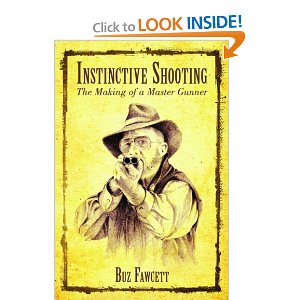There is a lot of talk going around now about instinctive shooting with a shotgun. Back when I came across these words, they were only whispered in a handful of obscure readings. And, I had experienced it before I had the words to describe it. We all have.
Instinctive shooting is loosely described as everything from shooting a BB gun without sights to shooting from the  hip. Since no two people ever seem to agree wholly on exactly what “instinctive shooting” is, I will define it as it applies to this book and our shooting school.
hip. Since no two people ever seem to agree wholly on exactly what “instinctive shooting” is, I will define it as it applies to this book and our shooting school.
Annie Oakley was a staunch supporter of instinctive shooting. In an early quote, Annie is reported to have said, “Shooting a shotgun is no more difficult than pointing your finger.” Annie taught in England for the princely sum of one pound per lesson in 1887 while the Wild West show made appearances in the British Isles. She returned to this country and eventually taught at Pinehurst, in North Carolina, until the time of her death. Annie’s deadly accuracy was combined with a shooting style of grace and beauty. A combination not seen again until, I believe, the Wingshooting Workshop followed on this same path towards instinctive shooting. But Annie never got her technique into writing.
Robert Churchill espoused an instinctive style in England during the early 1900’s. In reading his book, I believe that he ran into the same problems I did in my early years—it’s a whole lot easier to shoot instinctively, than it is to teach it.
Churchill came up with some pretty neat stuff, however. His shooting stances were a real contribution, but, I sincerely believe they were based on Annie’s teachings. Unfortunately, Churchill took Annie’s squared-away stance out and blended in a bit of the military protocols—always a danger in instinctive shot gunning.
Churchill’s patterning for fit is a contribution as well. But Robert Churchill wasn’t the only instinctive supporter to make his way into print. Lucky McDaniel copyrighted a book in l980 on instinctive shooting. McDaniel is better known for his teaching technique that first taught students, using BB guns, to shoot taped steel washers out of the air and eventually worked down to aspirin tablets and, finally, shooting another BB with a BB.
Down through the ages, most trick shots, Annie Oakley, Herb Parsons and the like, have used instinctive shooting to amaze and astonish. To the uninitiated, instinctive shooting does indeed seem to border on the miraculous. But it’s more than fodder for trick shooters.
An instinctive shotgun shooter has the ability to hit a moving object without establishing a perceived relationship between the barrel and the target.
Now that’s a pretty big statement. Because in most current descriptions of instinctive shot gunning, the writer continues with the definition… the shooter is only dimly aware of the barrel in the lower part of his/her vision.” In fact, when performed properly, the shooter has no perception of the barrel. If the shooter is looking at, or is even “dimly aware” of, the barrel or bead, he/she is concentrating on the wrong thing, and will miss. So let’s proceed a step further—if the shooter is establishing a relationship between the barrel and the target by: (1) Swinging the barrel along the flight path of the target and firing as he passes through the target; (2) Intersecting the barrel onto the target and firing as he pulls away along the apparent flight path of the target; and (3) Establishing a sustained lead ahead of the target—If these are the methods, then the shooter is simply aiming by our definition.
Frankly, it has been my experience that the conscious mind is not very adept at shooting moving targets. It is too analytical, non-spatial and slow.
In the first two of the three commonly taught methods mentioned above (Swing Through and Pull Away), the shooter depends on the lag in mechanical lock time and muscular reaction to hit the target. The shooter is actually attempting to move the shotgun at a speed faster than the target. But nobody tells the shooter how much faster. And it wouldn’t work even if they were told what speeds. At least, it would not work all of the time. The third commonly taught method (Sustained Lead) demands that the shooter first estimate the range, speed, angle, acceleration or deceleration and size of the target. He must then guess at the proper lead and shoot while trying to keep the barrel moving at the target’s speed. All of these methods are wrongfully focused upon aiming—aiming to swing faster than the target, aiming to pull away from the target, or aiming consistently in front of the target.
This reliance upon aiming of shotguns is even more obvious when we consider the firearm choice of most modern shot gunners: pumps, semi-automatics, and over-and-unders. These firearms offer the shooter, and you see this term commonly used by most modern gun writers, “a narrow sighting plane.” Believe me, if you are shooting instinctively and are POINTING the shotgun correctly, A SHOTGUN DOES NOT HAVE A SIGHTING PLANE.
The most brilliantly designed and most easily pointed shotgun is the classic side-by-side. The side-by-side in the hands of an expert can do everything the “narrow sighting plane” shotguns can do, plus the one thing side-by-sides do best—point naturally.
When an expert uses a side-by-side, missing a target becomes the exception. When the expert does miss, he or she knows exactly where the charge of shot went, and why.
-From our shooting instructor and inventor of the Wingshooting Workshop, Buz Fawcett


Leave A Comment
You must be logged in to post a comment.